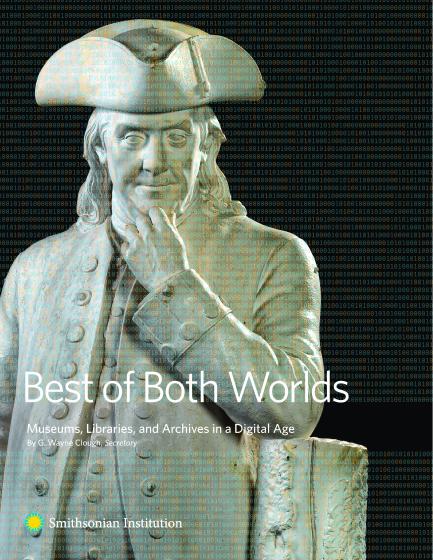Wayne Clough is the 12th Secretary of the Smithsonian Institution, leading the world’s largest museum and research complex with 19 museums, nine research centers, the National Zoo and research activities in more than 90 countries.
Smithsonian Secretary Presents E-book on Future of Museums
Wayne Clough, Secretary of the Smithsonian Institution, asks museums a fundamental question: “How can we prepare ourselves to reach the generation of digital natives who bring a huge appetite—and aptitude—for the digital world?” His thoughts on how the Smithsonian is tackling this issue and how others have fared in museums and libraries around the world are the subject of a new e-book, “Best of Both Worlds: Museums, Libraries, and Archives in a Digital Age,” available free online beginning Aug. 27.
The e-book begins with a summary of what has already taken place in libraries and archives—documents once available only in the stacks or back rooms are now available, often for free, through the Internet. The Library of Congress and the National Archives, along with thousands of local libraries around the country, have led the way in digitizing two-dimensional objects.
For museums, the digital world presents a bigger challenge. Clough cites several reasons for this. First, and most obvious: Producing images of three-dimensional objects is more complicated than taking a picture of a page and adding some data. Most museums, including the Smithsonian, previously have not had high levels of technical expertise and equipment. Adding to the challenge is the simple fact that collections are built with exhibitions in mind rather than open access on computers.
With 137 million objects in its care, how did the Smithsonian begin the process of digitizing its vast collections to make them accessible to the millions of people who do not visit the museums in person? Clough describes the journey that began in 2009 with setting priorities for what would be digitized—a total of 14 million objects.
“The physical museum offers visitors the opportunity to experience the real object and share their impressions with family and friends,” Clough said. “Digital access can then provide limitless opportunities for engagement and lifelong learning.”
Centers for Informal Education
Museums do not give degrees but they do provide informal education through their research, scholarship and exhibitions, both real and virtual. Clough sees museums gradually moving beyond showcasing collections to engaging the public online where the “visitors” can sort out and access the objects they find most interesting and then interact directly with the museums.
Education has always been at the core of the Smithsonian. Today, the Smithsonian offers materials and lesson plans that meet state standards for K–12 curricula; online national summits for teens on subjects such as the 1961 Freedom Riders, the environment and the 1930s Dust Bowl; the Collections Search Center website; and apps such as Leafsnap that allow people to take a picture of a tree’s leaf and have it identified in seconds. One of the most visible examples of informal education is the Smithsonian’s website, www.seriouslyamazing.com, which draws people in with fun questions and, with another click, takes them deeper into the subject. For example, when the question “What European colonizer is still invading the U.S. today?” is clicked on, the answer, earthworms, appears along with further in-depth information on worms from environmental researchers.
Call to Action
Museums have moved slowly—frequently project by project—into the brave new digital world, according to Clough. There are many good reasons for this cautious path, but “the time for toe-dipping is ending for museums, since they cannot stand aloof from the rising tide of information convergence.”
Clough concludes his 75-page online book with this thought: “While digital technology poses great challenges, it also offers great possibilities. For the Smithsonian and our nation’s other museums, libraries and archives, today is a time when we can serve the role our founders envisioned for the educational systems of our republic. We can help all the people, not just a few of the people, to understand our culture, the cultures of other countries and life in all its dimensions.”
To read the free book and see a short video, go to http://www.si.edu/BestofBothWorlds. The book is also available for free at iTunes U.
# # #
SI-346-2013
Linda St. Thomas
202-841-2517




